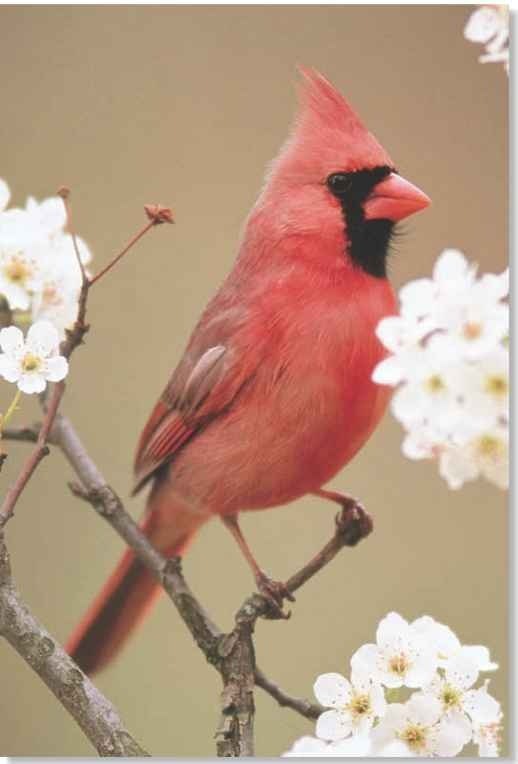ORDER
Passeriform.es
FAMILY
Emberizidae
GENUS & SPECIES
KEY FEATURES
• Both male and female sing year-round and have an extensive repertoire of calls
• Bright-red plumage and bold nature make the bird a familiar sight
• The cardinal rarely migrates and usually does not wander more than a few miles from its home
• Can adapt to habitats ranging from deep forests to city gardens
WHERE IN THE WORLD?
Found in Canada, the United States from Maine to Florida and | as far west as Minnesota and the western prairies in the Southwest, south to Mexico and Belize; also in Bermuda and Hawaii

LIFECYCLE
The Northern cardinal displays a unique combination of bold song, color and character; it prefers to stay close to the place of its birth and rarely migrates.
HABITAT
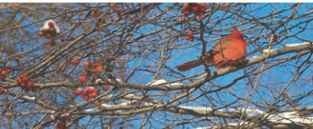
A Staying put The cardinal tolerates the cold across its
Also known as the red-bird, the northern cardinal lives in dense thickets along field borders, in hedges, swamps, stream banks, parks and gardens. The habitat of this mainly nonmigratory bird is temperate, but its range can include desert conditions. On the arid \
Marias Islands off Mexico, the cardinal gets enough water by drinking the early-morning dew.The cardinal lives year-round from the Dakotas, southern Ontario, and Nova Scotia to the Gulf Coast, and from southern Texas west through Arizona and south through Mexico to Guatemala. The bird was introduced in Hawaii in 1929.
Northern cardinals are named for the brilliant red robes worn by the Roman Catholic cardinals.
The cardinal is the state bird of several northern and southeastern states, including Illinois, Indiana, Kentucky, North Carolina, Ohio, Virginia and West Virginia.
According to Cherokee legend, the northern cardinal was originally brown in color. The bird helped a wolf, which, in thanks, told the cardinal where to find a rock with red paint. The cardinal then painted himself red.
FOOD & FEEDING
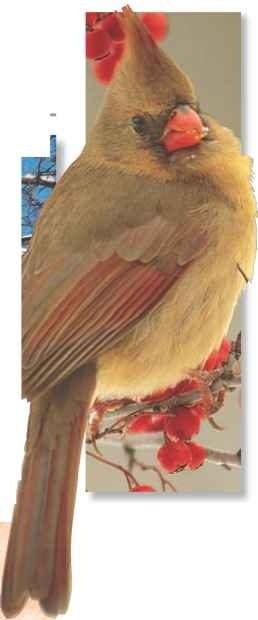
Seeds, fruits, insects and spiders make up the cardinal’s diet. In the wild, the cardinal gleans food from nearby trees and shrubs. Its wedge-shaped beak allows the bird to eat all kinds of seeds, which it holds with its grooved, upper mandible while moving the lower mandible forward to crush and husk the seed. The bird then swallows the seed’s inner “meat.” During fall, the cardinal ascends to tops of trees and bushes in search of grapes and berries; in the winter, the bird picks up seeds and forages around haystacks at farms. The more domesticated cardinals collect food from town gardens as well as from backyard bird feeders, favoring sunflower seeds and cracked corn. Their full menu includes 51 kinds of insects and spiders, 33 kinds of fruit and 39 types of seeds.
BEHAVIOR
The cardinal’s song plays a role in all aspects of its life, from socialization to courtship to nesting. The male swells his throat, spreads his tail and drops his wing as he sways from side to side, appearing to delight at the sound of his own voice. Females begin singing their softer song in March, while males sing year-round. Both sexes defend their territories, usually a few acres in size, through the songs that they sing.The female drives out intruding females, and the males fiercely guard against other males. Songs also serve as signals, letting respective partners know when they are coming or going. The young can sing as early as 3 weeks old, but they do not aquire adult phrasing for two months.
A splendid sip
A cardinal fans its wings as it prepares to swallow.
THE ART OF FEEDING
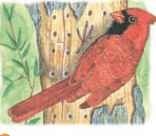
Follow the holes…
A male cardinal maintains a tight grip on a willow tree as it drinks from a hole previously drilled by a sapsucker.

Patience pays off…
A female cardinal, using her strong beak as a probing tool, discovers a large grub beneath the loose bark.
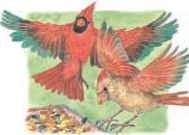
Easy dinner…
This cardinal pair finds its next meal without much effort on one of many bird feeders supplied by helpful humans.
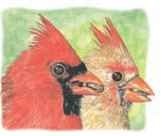
Skilled shellers
Their broad, strong beaks manipulate the sunflower seeds; they make cracking open seeds appear almost effortless.
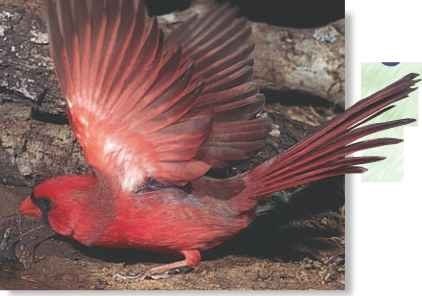
BREEDING
Fiercely loyal, the cardinal forms strong bonds and mates for life. During courtship, the male not only serenades his prospective mate but also feeds her The love serenade is clear and sweet, often lasting all day. Nest building starts in March and April. The female builds a cuplike nest made of dry leaves and twigs, usually in a tree 4-5′ above ground near a stream used for drinking and bathing. She adds grass and grapevines to complete the woven structure, before adding a final lining of softer materials, including rootlets and hair; It takes her about 3-9 days to complete the structure; she builds for a few hours in the morning, then a few more in the evening. The male continues his song as the female incubates the 3-4 dull white eggs with brown spots. The hatchlings are blind and helpless, with pink skin sparsely covered with gray down. Depending on the region, the cardinal pair raises from 2-4 broods during the season. The male brings insects to the young, which have large gaping mouths with red linings — easy targets when being fed. The male also guards the first nest, while the female prepares a new nest, usually about 30′ away. Once the new young hatch, the juveniles of the first brood, about 3-4 weeks old, are chased from the parents’ territory.
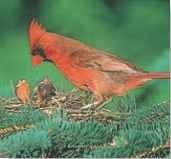
A Single parent The male brings food to the two hungry chicks, while the female prepares another nest.
CONSERVATION
With the northern cardinal’s ability to adapt to almost any environment, this abundant species does not appear to be in any immediate danger.The bird has adapted to the Everglades of Florida and the evergreens of New York, the deserts of Mexico and suburban gardens of New Hampshire.Though sought after for the caged-bird trade in the 19th century because of its songs and brilliant plumage, the northern cardinal is currently protected. Its domestic nature, brilliant color and pleasant song make the bird welcome at bird feeders in gardens and backyards in populated areas throughout its range.
PROFILE
Northern Cardinal
The northern cardinal is a familiar and welcome sight in its year-round homes, with its rich red plumage and melodic songs.
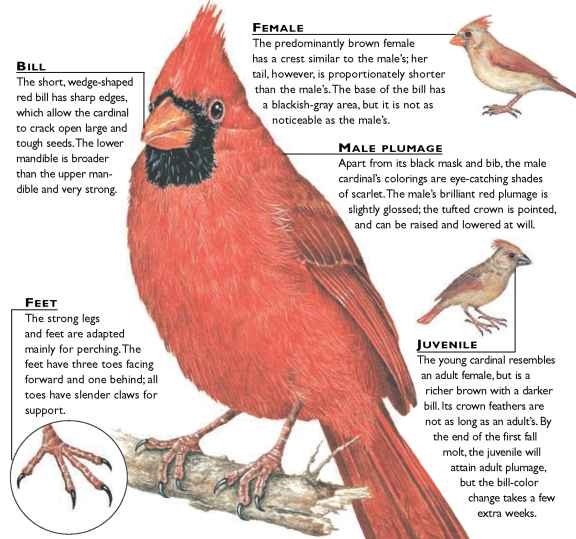
CREATURE COMPARISONS
Measuring up to 7.5″, the red-crested cardinal (Paroaria coronata) is slightly smaller than the northern cardinal. Its gray upperparts and white underparts are accented by a large red crest on its head, throat and upper breast, quite different from the primarily red coloring of the northern cardinal.The red-crested cardinal inhabits South American savannah in Brazil, Uruguay, Paraguay, Bolivia and Argentina, where it sings from the treetops or bushes. Its path never crosses that of its northern cardinal cousin, which resides mainly in North
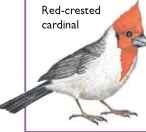
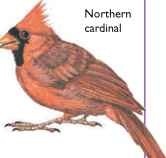
| VITAL | |
| STATISTICS | |
| Weight | 1.25-2 oz. |
| Length | 7.5-8.5″ |
| WlNGSPAN | 10.25-12″ |
| Sexual Maturity | 1 year |
| Breeding Season Is- Number of- Eggs |
March-August 2-5, usually 3-4 |
| Incubation Period | 12-13 days |
| Fledging Period | 10-11 days |
| Breeding Interval | Up to 4 broods a year |
| Typical Diet | Seeds, berries and insects |
| Lifespan | Up to 28.5 years in captivity |
RELATED SPECIES
• The northern cardinal is one of several species in the genus Cardinalis. Its closest relative in
North America is the pyrrhuloxia, C. sinu-atus; a South American relative is the vermilion cardinal, C. phoeniceus. These birds are among 47 species in the family Emberizidae. The family includes the yellow cardinal, Gubernatrix cristata, as well as the red-capped cardinal, Paroaria gularis.
